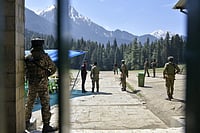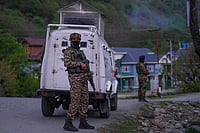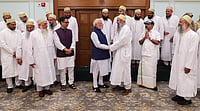In the first week of May, as the news of senior BJP leaders campaigning for national secretary Pankaja Munde—contesting from the Beed constituency—reached the villages around Vangi, 17 km from Beed, hundreds of angry villagers descended at the highway junction and blocked the convoy.
Not a single vehicle of party workers was allowed to enter the cluster of dozen villages, Vijay Supekar, the sarpanch of Shivne village, who participated in the demonstration, said. “Nearly 700-800 Maratha youth gathered from the neighbouring villages and gheraoed the cars. We told them we were angry and would not allow the BJP to campaign in our villages,” added Supekar, who also hails from the Maratha community.
In the last 15 years, the BJP wasn’t even required to campaign in Beed as villagers blindly voted for the BJP and the Munde family, Supekar said. Out of the six Assembly seats in the Beed Lok Sabha constituency, five are with the Mahavikas Aghadi ruling alliance, of which Parli, Ashti and Majalgaon are with the Ajit Pawar-led NCP, while Gevrai and Kaij are with the BJP. Beed is the lone Assembly seat with Sharad Pawar-led NCP.
In December, the Gram Sabha of Shivne passed a resolution to vote against the BJP in the coming elections. “The BJP government did not do justice to the issue of Maratha reservation. They tormented our leader Jarange Patil, who had to sit on hunger strike time and again,” Supekar added.
Similar reactions and resolutions against the BJP have emerged from other villages across the Beed district, which has nearly 40 per cent of the population—approximately 7.5 lakh from the Maratha community, followed by Vanzara at 3.5 lakh, and Muslims and Dalits at 2.5 lakh each.
The Munde family, belonging to the Other Backward Class (OBC) Vanzara community, has maintained its prominence in the Beed district for 25 years. The late Gopinath Munde won the Lok Sabha seat twice, in 2009 and in 2014. After his accidental death, his daughter, Dr Pritam, won the by-poll with an astounding margin of 6 lakh votes, second only to Prime Minister Modi’s vote share. She retained the seat in 2019 as well, but the BJP cancelled her ticket and fielded her sister Pankaja instead. Dr Pritam was slammed over her performance as an MP in Beed after reports emerged that she used less than 60 per cent of her MPLADS funds.
But it is the politics around the Maratha reservation that has undermined Pankaja Munde’s position against her opponent Bajrang Sonawane, a farmer from the Maratha community, contesting on Sharad Pawar-led NCP ticket.
Munde’s past comment stating that one does not get a reservation by going on a hunger strike is particularly weighing heavy against her as it is seen dissing quota activist-turned- mass leader Manoj Jarange-Patil, who stirred the agitation, demanding reservation for Marathas.
“This time, the elections in Beed are clearly being fought on caste lines. There’s a straight Maratha vs OBC fight, as large numbers of Marathas are rallying in support of Sonawane,” says Dnyandev Kashid, one of the leaders of the Maratha Kranti Morcha, the outfit behind mass-scale protests and agitation for the reservation of the Maratha community.
The repercussions of the Maratha agitation are being witnessed in Jalna and Aurangabad—renamed as Sambhajinagar—which heads to polls on May 13. “The reservation issue is burning in the entire Marathwada region, and particularly Jalna and Beed districts, which witnessed large protests. The Maratha community, which has a high vote share in the region, feels deceived and is aggrieved with the Shinde-led goverment for not fulfilling their reservation demands,” says Angad Taur, an academic and a Jalna resident
The drought-prone region of Marathwada, ill-famed for the high numbers of farmers’ suicides, has fought for reservation quota since the 1970s. The movement was revived again by Jarange-Patil in 2014 after the Bombay High Court stayed the 16 per cent reservation for Marathas in government jobs and educational institutes by the Congress-NCP-led government. It has continued to rock Maharashtra since then following the predictable cycle of protest demonstrations, government assurances to meet the demands, setting of high-powered commissions, study reports, field surveys and court petitions.
Last year, the movement turned violent in the Beed and Jalna districts after police action against protestors. Mobs of angry youth attacked properties and houses of elected representatives and over a dozen Maratha youths died by suicide over the government’s delays in meeting the reservation demands.
In February, ahead of the Lok Sabha polls, Chief Minister Eknath Shinde led government tabled a bill for a separate 10 per cent Maratha quota that was unanimously approved by the state assembly. But Marathas have rejected the special reservations as it did not fulfill its demand of recognition of all Marathas as Kunbis so that they can avail of quota benefits under the Other Backward Class (OBCs). Jarange-Patil and others have sought recognition for Marathas as the ‘sage soyare’ or the immediate kin and blood relatives of Kunbis.
Constitutionally, there is provision for reservation in only three categories—Scheduled Caste, Scheduled Tribe and OBC, so that socially and economically backward communities can prosper with education and jobs, says advocate Bhanudas Jadhav, the convenor of the MKM in Beed. “The fourth category of separate quota for Marathas as approved by the BJP-led government does not hold in the eyes of law, he said accusing the Shinde government of deceiving Marathas with false assurances.
According to him, the sharp reactions against the BJP during this election are due to the government’s fiasco over reservation. Marathas don’t trust Home Minister Devendra Fadnavis, who assured positive action to Jarange Patil but failed to implement our quota demands.
Marathas are the dominant caste in Maharashtra, constituting nearly 35 per cent of the state’s population. It includes groups and sub-groups from ‘96 koli Marathas’ to the agrarian Kunbis and economically weaker classes who work as sugar cane cutters and are highly discriminated against within the community. The community also rules state politics with nearly 11 of the 18 chief ministers belonging to the community, including CM Shinde and his deputy Ajit Pawar.
But unlike the Marathas in Konkan and Western Maharashtra, who are recognised as Kunbis and have benefitted from reservation under OBC, Marathas in Marathwada haven't because the community is notified as Kunbi but not as Marathas. “When Marathwada was under the Nizam rule, the population census had only two categories, Muslims and Marathas. Our caste was noted as Marathas, not Kunbis,” says Jadhav.
The Marathwada region, comprising the present-day Aurangabad, Jalna, Parbhani, Nanded, Beed, Latur and Osmanabad (now Dharashiv) districts, was under the rule of Nizam of Hyderabad from the 17th century. The Indian army liberated Hyderabad and the Marathi-speaking parts were merged with Maharashtra on September 17, 1948.
Spread over eight districts, Marathwada is populated by Marathas, Dhangar, Vanzari and Dalit communities. It is geographically the state’s largest region and was renowned as the sugar and cotton bowl of Maharashtra. However, the region’s characteristic erratic rainfall, drought-like conditions, and conflicts of interest over sugar co-operatives and cotton spinning mills by political dynastic families have contributed to the continuing downfall. In the Beed district located at the centre of the Marathwada region, several of these factors come to a head, adding to its extreme poverty, and social and economic backwardness.
“There are no large-scale industries or companies here generating employment or income sources for the people here. Most struggle to survive as daily wage labourers and marginal farmers. But instead of addressing the developmental needs, politics in Beed has revolved around caste polarisation and caste prestige,” remarked Sanjay Malani, co-editor of Prajapatrak, a local rights-based newspaper. “The Marathas have developed a belief that all their problems will be resolved through reservation.”

Beed, the hometown of the state’s agriculture minister Dhananjay Munde—cousin of BJP Lok Sabha candidate Pankaja—has the highest number of farmer suicides. Of the 685 farmer suicides recorded in 2023 in Marathwada, 186 were in Beed. Failure to implement irrigation projects, the lack of adequate rainfall, extreme heat and drought conditions have resulted in persistent crop failures, turning Beed into the epicentre of farmer suicides. Every week, tens of people from farming families take their lives by consuming pesticides, jumping in wells or hanging by trees.
Over 80 per cent of farmers committing suicide belong to the Maratha community.
Just last week, in the Ahervadaon village of Beed taluka, Rahi Rohate, a Maratha woman, hanged herself in the middle of the night, as her six-year-old son and husband were deep asleep. “There are a lot of problems … of farming, debt, but we were managing our household. I don’t know why she took such an extreme step,” said bereaved husband Ashok Rohate.
The couple, belonging to the Maratha community, decided to only have one child due to their inability to manage the expenses of a large family amid rising inflation and poor crop prices. Ashok and Rahi toiled on their one-acre farm, growing jowar and bajra for their family’s consumption and soyabeans to sell in the market. “Last year, farming was difficult due to very less rainfall. We managed to grow some soyabeans, but their selling price has drastically reduced and the amount is not enough to last us a year,” Ashok said, expressing doubt about whether he can even avail the government-handed compensation to farmers as incidents of women committing suicide are rare.
Most of the 4,500 villagers of Ahervadgaon sustain on marginal agriculture of jowar, bajra for household consumption and cultivate soyabean to sell in the market. The rate of soyabean has declined last year from Rs 7,000 a quintal to Rs 2,500.
“There is no good rate for the crops. Farmers have grown more desperate in the last five years,” said Bappa Narayan Tawre, former sarpanch. The village has seen at least ten farmers suicides since 2020, many of whom were under the age of 40 years and had nominal debts of Rs 2 to 5 lakh.
Tawre feels marginal farmers with no other income source are trapped in the cycle of crop failure and debts, which adds to their helplessness. “Suicide becomes an easy way to end this trap. By doing so, at least their families get some compensation,” he said.
A Maratha himself, Tawre is confident that implementing reservation in government jobs will release farmers in the district out of the misery of inflation and drought. “One hundred per cent, our problems will be solved with reservation. Even if one member from each household gets a government job, it can help the extended family and relatives to prosper economically.”
Besides rain-fed agriculture, a quarter of Beed’s 31 lakh population is dependent on employment as sugarcane cutters, many of whom belong to the Maratha community. From October to April, district’s six lakh population migrates to the estimated 109 sugar factories spread across Ahmednagar, Kolhapur, Solapur, Satara and Sangli for the harvest. Some even venture to the southern states of Telangana and Andhra Pradesh.
“Sugarcane workers are among the most exploited, and are kept as semi-bonded labourers by the contractors for six months in a year,” says labour rights activist Manisha Tokale. They return to their villages during the farming season. If it rains adequately they can fill their house with jowar or bajra to eat, if not, they take loans to survive and entangle themselves in a debt cycle, working on sugarcane fields for free. “Beed’s economy is dependent on farmers and sugarcane workers, but unfortunately both the groups, do not benefit from any of the government’s schemes.”
Marathas in Beed aspire to change the stark ground realities by taking political power into their own hands. Locals claimed under the Munde family’s rule, no other OBC community has benefitted as much as the Vanzara community, which commands all the top government and police posts in Beed.
Jarange-Patil recent announcement that Marathas will fight the upcoming state assembly elections by fielding their own candidates, has further emboldened the community, notes academic Taur. “The Muslim community has openly supported Maratha reservation and will be a game-changer in the elections against the BJP,” he said.
Kashid from the MKM said this is the first time that, Marathas have become politically aware of their representation and have consciously decided to not participate in political events or election campaigning of non-Maratha candidates or for the BJP. “The implications of this vote consolidation will have a lasting impact on the politics in Marathawada but also all of Maharashtra,” he said.





























